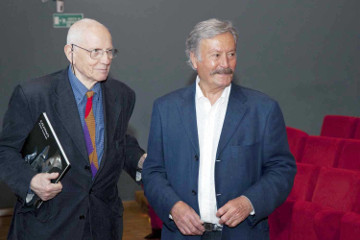
Giuseppe Calonaci
Giuseppe Calonaci was born on 1931 in Poggibonsi (Siena) where attends the local school of art, “Piccola Accademia del Dopoguerra”, studying with the French painter Lionello Bonamici, Pilade Moni, Silvano Bozzolini and Otello Chiti (Biennial Prize in 1932).
Then in Florence, with "Classical Abstraction”, Calonaci is involved in the cultural activities of that period known cooperating with the Florentine Avantgarde and Fiamma Vigo, curator of the Art Gallery “Numero” (Florence, Venice, Rome). Other exhibitions: at “Giorno” in Milan, with “D’Ars Agency” by Vittoria Palazzo; at Reggia di Caserta, by Flavio Quarantotto; at Giraldi art gallery in Livorno; at 2B in Bergamo; at “Grattacielo Pagani” in Milano and, at the same time, at Parco di Castellanza with his scuplture; on the occassion of the “Venice Biennale”, at “Scuola Grande di San Teodoro” (by Galleria Numero); at Vanvitelli’s Foro Carolino in Naple, by Flavio Quarantotto.
In the 1953, Calonaci sets up, with a crew of 20 artists, the project named “SIVA”, creating works in steel and glazes cooked to 900°, with the aim of the development of art and craft in the society. Few years later, the French architects and sculptor André Bloc wrote a basic test about Art and society in the magazine “Art d’Aujourd’hui”.
Amongst Calonaci’s personal exhibitions we also remember: Herr Chambliss Fin’ Art in Hot Spring, Arkansas where he was awarded the rank of “Ambasciatore Onorario” by the US President Bill Clinton; “Porta della pace” (bronze cm. 320x310), Poggibonsi; “Cattedrale della luce”, concrete building (h.18, base 35 meters), Barberino Val d’ Elsa (Firenze).
In Japan, Maeda Environmental Art buys painting and Bronze Sculptures for the exhibition in Tokyo (Japanese catalog; in “Maeda New” magazine, vol. 67, on the magazine cover “Pala della memoria”); subsequently he exhibits his works at the Biot Co Art Gallery in Tokio. Siena, Santa Maria della Scala, by Omar Calabrese. In Florence, he is being honoured with rank of “Accademico dell’Accademia delle Arti e del Disegno” by Francesco Adorno.
In Rome, at “Palazzo delle esposizioni”, as at “Archivio Centrale dello Stato” (EUR) Calonaci takes part at “Come l’ombra”, art symposium in honour of Marguerite Yourcenar by Claudio Crescentini, along with the artist Arnaldo Pomodoro, Joseph Beus e Lopez.
In Florence, Calonaci shows “Citta Verticali” in Palazzo Pitti, Giardino di Boboli and in Accademia delle Arti del Disegno, by Enrico Crispolti, Corrado Marsan, Nicola Micieli, written works by Luigi Zangheri and Cristina Acidini.
Always in Florence, Calonaci is being honoured as “Accademico in the name of Erato” by the International Academy Le Muse; amongst the honoured: Henry Moor, Marc Chagall, Emilio Greco, Giacomo Manzù, Giò Pomodoro, Fernando Botero, Jean Michel Folon, GiulianoVangi.
Amongst Calonaci’s numerous Happening in around the word, we remember: “Stella nel deserto”, 1995, Palmira (Siria); “Immigrazioni 3”, 2001, Anghòr (Cambogia).
In 2015, in Poggibonsi, Calonaci shows at the exibition space H-B, PARETE OCCUPATA / ASTRATTO CONCRETO, by Enrico Crispolti, Marco Meneguzzo, Nicola Micieli, e Corrado Marsan. In 2016 he shows PARETE OCCUPATA in Prato, Villa Medici “La Ferdinanda”, by Nicola Micieli.
Since the 2000s, Calonaci works on the project PARETE OCCUPATA / ASTRATTO CONCRETO. The art piece comes in and occupy the wall, but sometimes is the wall which comes in the art piece and becomes Form. In its development, the work of art takes a new concept and it becomes Place, as in “Borgata d’Europa”, “Borgata Italiana”. In the Calonaci’s work, Art-Architecture-Technology merges in one only idea.
Calonaci says that the art work is a set of shapes and colours. If this relationship is perfect, the beholder will have a feeling of certainty, a constant pleasure, as if he was listening to a distant a perfect melody, a consensus stability, a feeling of equilibrium calculated during the Calonaci’s creative action. There is an inner will of the artist to propose an image which become and represent with lucidity his political and intellectual will.
To end the text:
Nicola Micieli on “Parete Occupata” writes: ... “in the analogue correspondence of formal variables, reflects, as a fractal, a possible hypothesis of the structure of the whole universe.”
Marco Meneguzzo on “Parete Occupata” writes: … “the space visually and conceptually occupied by the art work that goes far beyond the boundaries of the work, in order to occupy the wall space that, perceptually isolating the art work from the rest of the space, become to be part of it.”
Enrico Crispolti on “Parete Occupata” writes: … “since the formal-compositional construct that characterizes these paintings may emerge from a much wider environment that is therefore connected. And, one might say, offering the formal construct new communicative responsibilities”.
Essential reading list:
# - CALONACI, Le Macchine del Sole, a cura di Nicola Micieli, introduzione di Enrico Crispolti,
Lalli Editore, Poggibonsi, 1991
# - CALONACI, Dalla Forma pura alla contaminazione iconica, Alsaba Edizioni, Siena 2004
# - CALONACI, Città Verticali, a cura di Enrico Crispolti, Corrado Marsan, Nicola Micieli,
Bandecchi&Vivaldi Editori, Pontedera 2009
# - CALONACI, ASTRATTO-CONCRETO, PARETE OCCUPATA, a cura di Enrico Crispolti, Marco Meneguzzo,
Nicola Micieli, Bandecchi&Vivaldi Editori, Pontedera 2015

